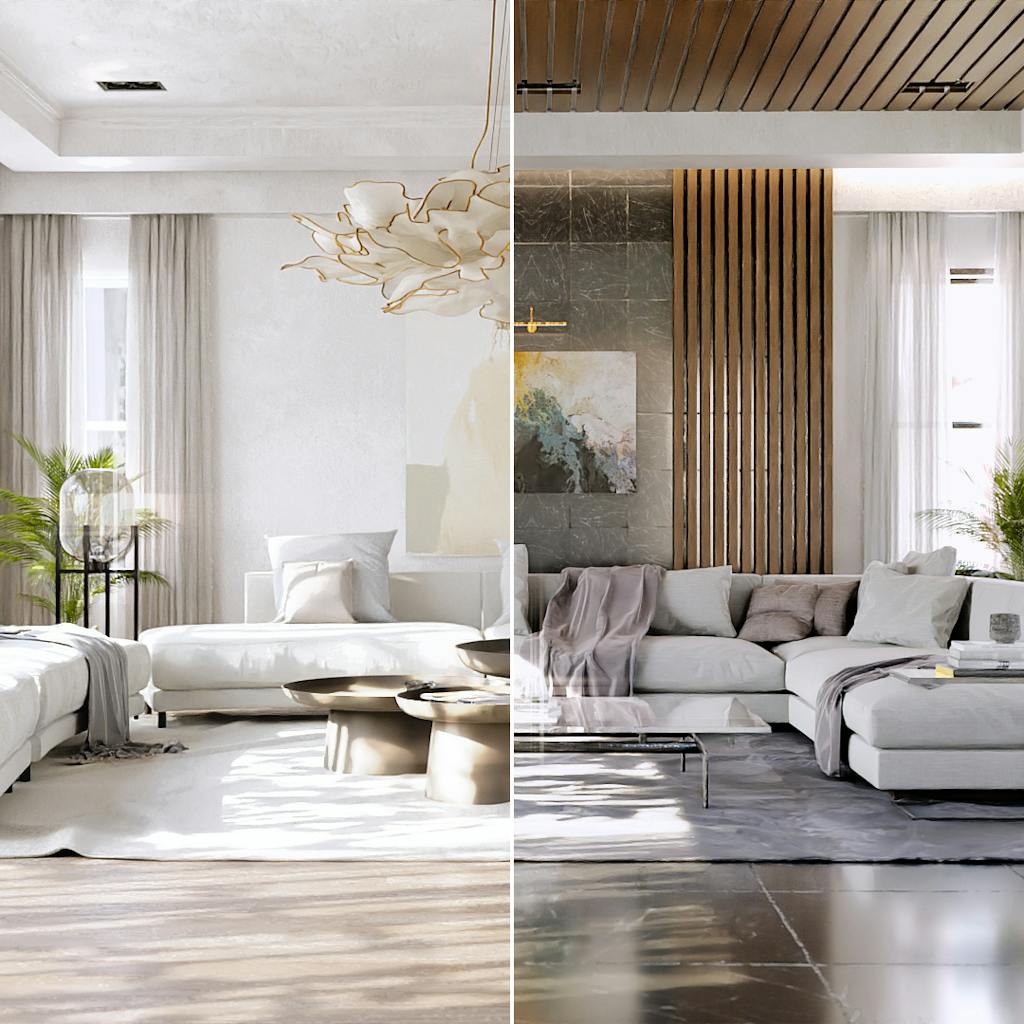Differences between Modern and Contemporary Style
Mar 4, 2022
11 min
Can you tell which among the two photos below is contemporary and which is not?

Are you finalizing your custom home interior? Were you considering the contemporary style or the modern?
Aren’t they similar? You may have asked yourself.
No, they aren’t.
Here are their differences:
1. Time
Contemporary design became popular in the 1970s, and it came from a spirit of individualism and international influences. It continuously existed from time to time. Modern design began earlier than Contemporary. Modern design was a way to get out of the excessive ornamentation of the previous era. Its origin can be traced to the Arts and Craft movement that began in Britain to oppose the inhumane impact of late 1800s industrialization. It further developed and became the core of the Bauhaus movement in 1919, whose primary principle is “Form follows function.” Modern design existed from the 1900s to the 1980s. See the details below:
1900s - 1950s: Modern
1950s - 1960s: Mid-century Modern
1970s - 1980s: Postmodernism
2. Key proponents
Some known artists who are believed to create contemporary designs are Mario Botta, Frank Gehry, Jean Nouvel, and many others. While Le Corbusier, Charles and Ray Eames, and Florence Knoll are the known proponents of Modern design.
3. Styles
The contemporary design borrowed elements from many styles such as minimalism, art deco, deconstructivism, and the list even includes modernism. Meanwhile, Modernism is focused more on minimal functionalism as it was known to reject the lavishness that preceded it.
4. Elements
Contemporary showcases styles “of the moment” which means it adopts the elements of any trending design. Thus, the contemporary design elements– its form, color, line, texture,-- vary from time to time. But according to Design Ideas Guide, Contemporary design includes ideas and elements that have been steady over the years:
- Simple Spaces without clutter (same with Modern design, probably the reason most people confuse modern with Contemporary),
- Exposed elements, i.e., wooden sofa legs or exposed beams.
- Organic silhouettes
Modern design style has a fixed definition of its elements:
- Crisp lines (found in some contemporary designs), Strong lines.
- Neutral palettes, mostly accents black and white
- Balance
- Functional decor pieces (since Modern design follows the Bauhaus movement’s primary principle, “form follows function.”)
Now that we have shared with you the differences between Contemporary and Modern design in terms of time, key proponents, styles, and elements, let’s have a look at some of their similarities in terms of the benefits and drawbacks.
Benefits of Contemporary style:
- Contemporary design is often used by artists who are into custom home designs that aim to reduce carbon footprint. The popular contemporary design uses ordinary and straightforward materials which are raw and natural. (Less process, lower carbon consumption).
- Since Contemporary design blends different elements, the house interior which employs this style rarely looks outdated.
- Often spacious.
Benefits of Modern style:
- The open-concept space incorporated in this style makes the custom home’s space wider and allows for fluidity in house re-arrangement.
- Since Modern design involves the usage of large windows or glass doors, sunlight can easily illuminate the room, allowing for lower energy consumption. This feature also allows your client to easily enjoy outdoor views, especially if they live in higher places that overlook the city or nature.
- Modern designs are also eco-friendly, like the Contemporary styles. The two styles also have some similarities in the furniture to choose from because they are both popular. With popularity comes more comprehensive furniture and home decor options and, therefore, lower prices.
In this section, note that the benefits of Contemporary and Modern designs mostly coincide with one another. The same is true for the drawbacks of having these styles.
- Both styles' popularity pushes the furniture industry to produce a lot of furniture and designs that might make one custom home a version of another. Thus, if you want your furniture to stand out, you may want to choose another style with more variations.
- Modern and Contemporary designs don’t easily fit with the exterior of any home. If you wish to have a quaint house exterior with a modern vibe interior, renovating it with a modern or contemporary style may not look as appropriate as it can be. If you still want to push through with your designs, you should carefully plan for it, which may be time-consuming and more costly.
See the examples of 3d rendering interiors below to know the visual difference between contemporary and modern design:
Right after reviewing the differences between Modern and Contemporary designs, which one do you think suits best for your custom home interior in Tampa Bay?
This article was last updated on Dec 12, 2025
Share